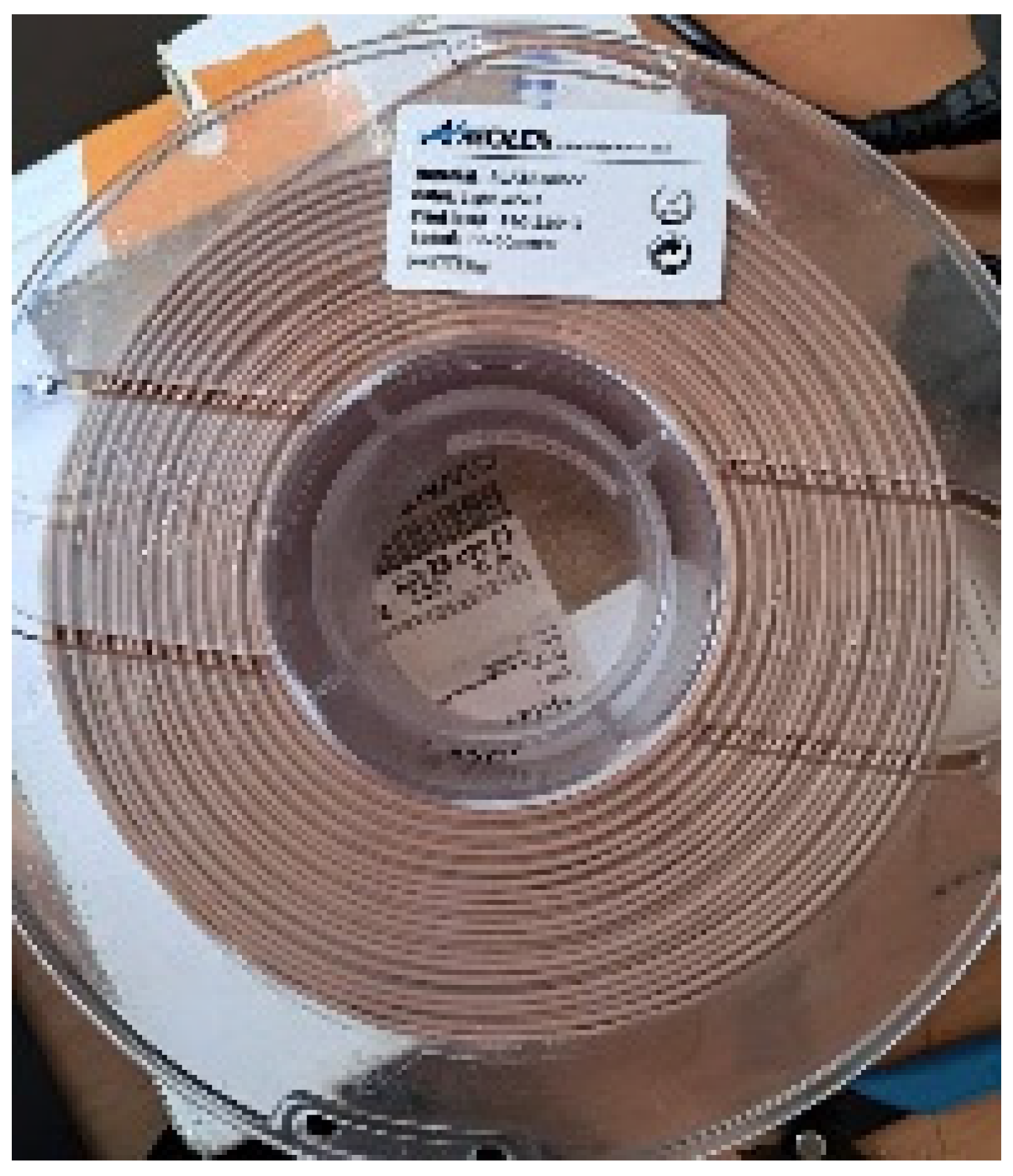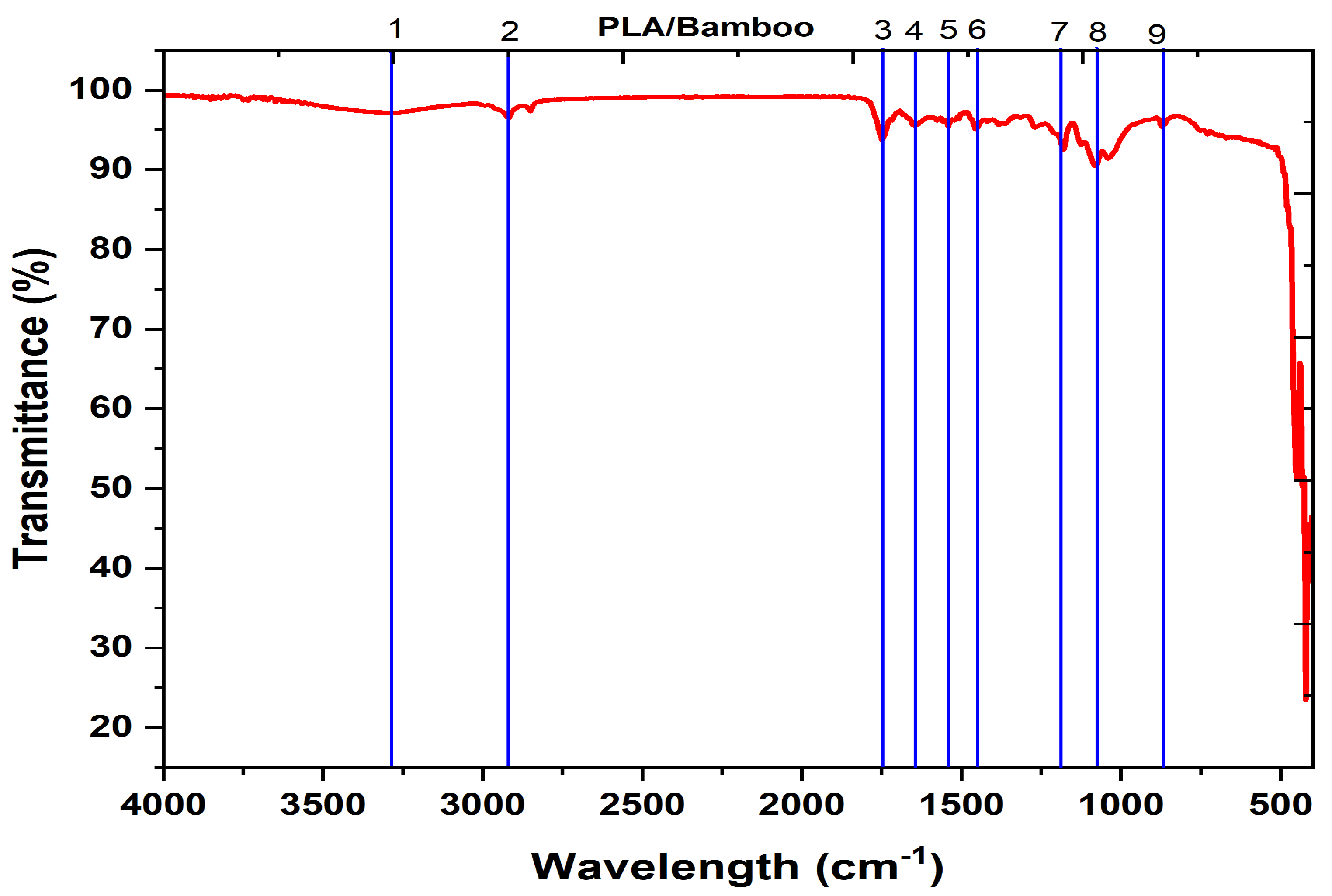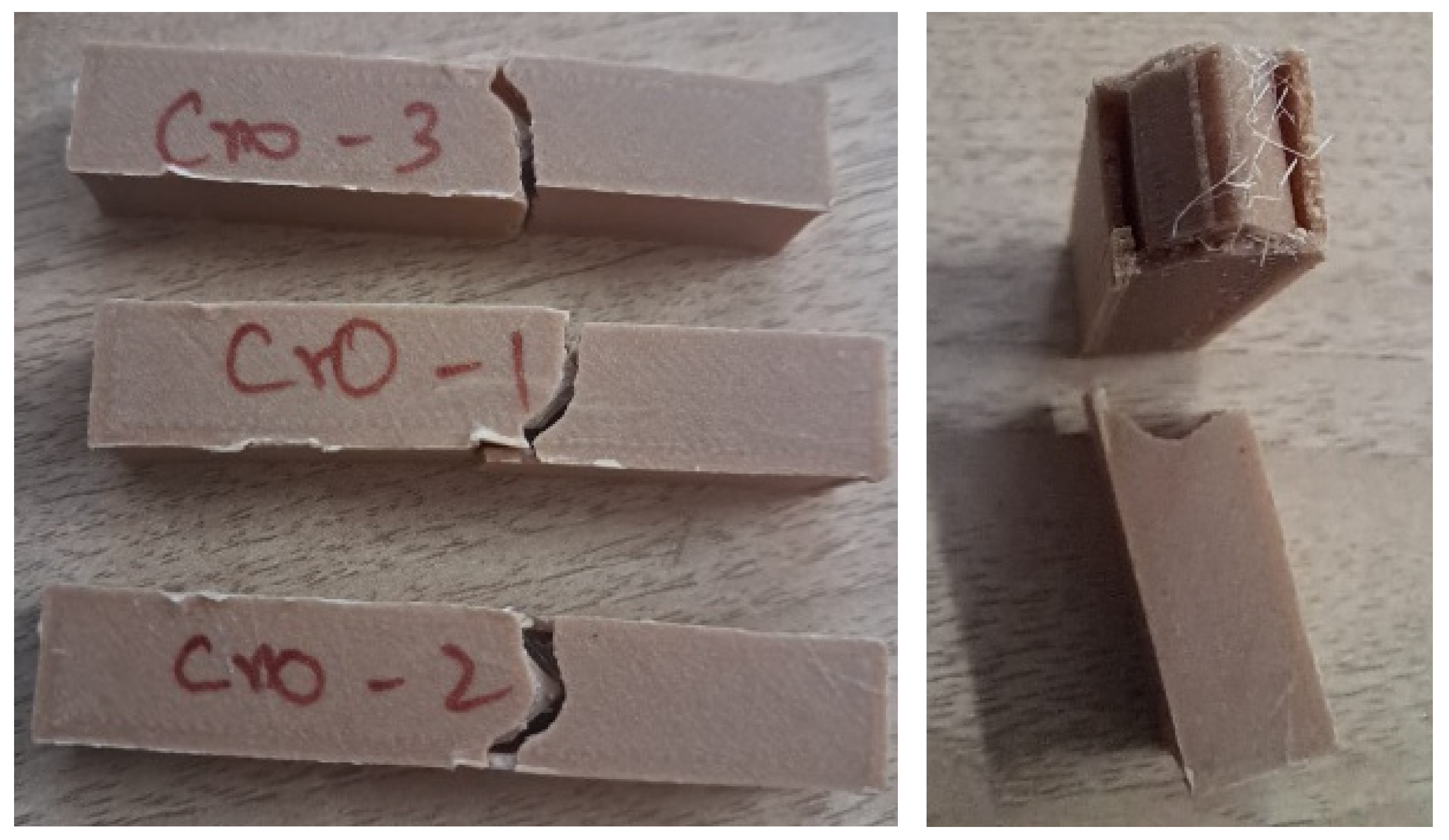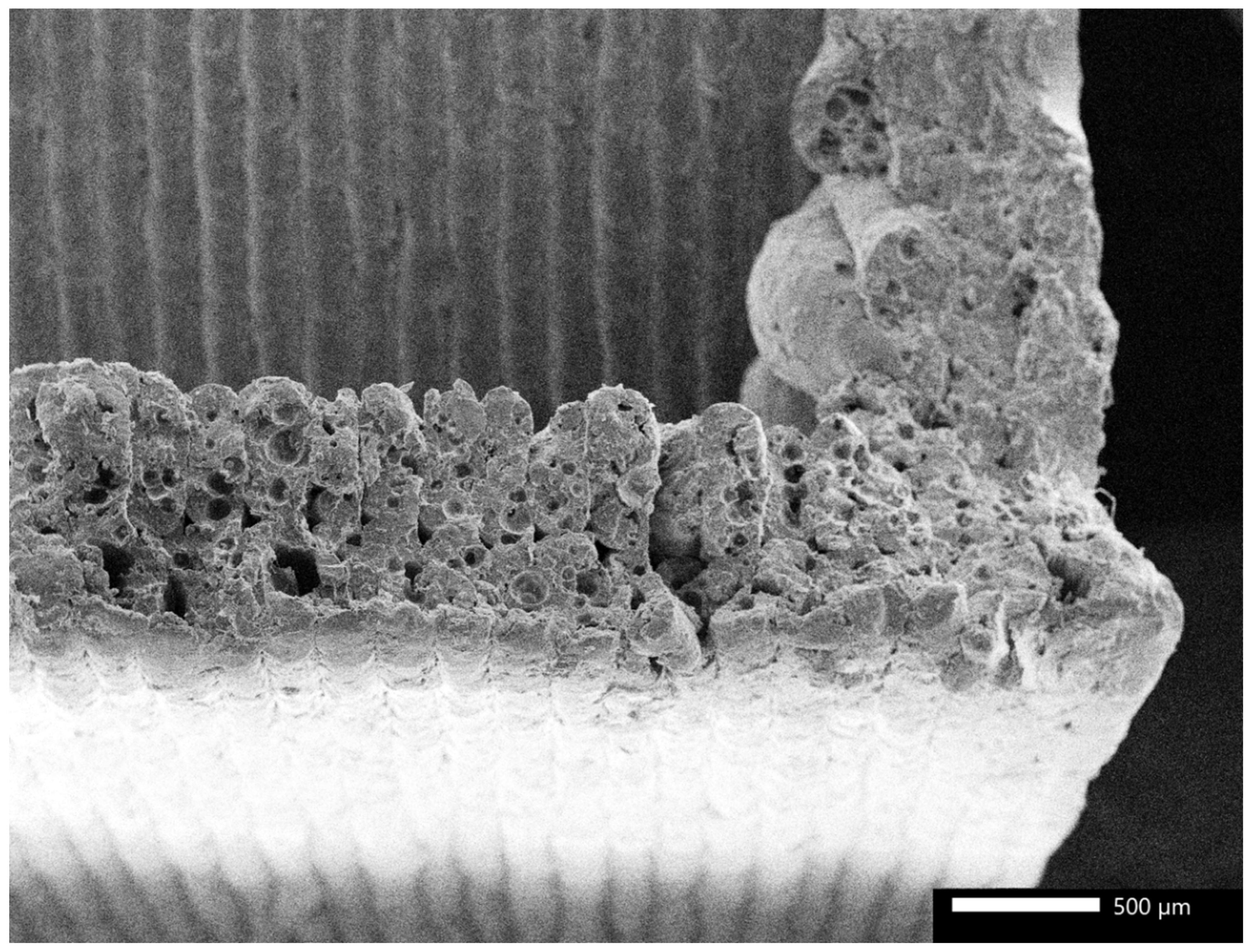Effects of Infill Patterns on the Mechanical and Tribological Behaviour of 3D-Printed Polylactic Acid/Bamboo Biocomposites for Structural Applications
Abstract
1. Introduction
2. Materials and Methods
2.1. Materials
2.2. 3D Printing of Composites
2.3. Expeirmentation
2.3.1. Mechanical and Tribological Testing
2.3.2. Characterization
3. Result and Discussion
3.1. Characterization of PLA/Zn Filaments
3.1.1. Fourier Transform Infrared Spectroscopic (FTIR) Analysis
3.1.2. X-Ray Diffraction (XRD) Analysis
3.2. Mechanical Behaviour of PLA/Bamboo Composites
3.2.1. Impact Properties
3.2.2. Hardness Test
3.3. Effect of Infill Pattern on Tribological Properties of PLA/Bamboo Composites
4. Conclusions
- →
- FTIR results exhibited the presence of cellulose and lignin, portraying the dispersion of bamboo in PLA. X-ray diffraction analysis revealed that the crystallite size of the composites was 23 nm. The presence of condensed particles in the composites aided in better load-carrying capacity by offering better stress transfer, resulting in better mechanical properties of the biocomposites.
- →
- Impact test results showed that the cross infill pattern, with its crisscross stress distribution, had the greatest impact strength (6.51 J/cm2) due to less stress, and localized failures occur when lines intersect regularly due to the improved interlayer bonding. When compared to irregular geometries such as Gyroid and Tri-hexagon, cross infill patterns demonstrate superior impact resistance.
- →
- Morphological analysis of the impact failure specimen portrayed that the interfacial bonding between the layers and the materials was commendable, which contributed to the least failure initiation during impact load. Infilling of the honeycomb structure with another infill pattern contributed towards the load sharing and effective stress transfer during the loading.
- →
- Hardness test results showed that the pattern with the grid infill had the greatest Shore D hardness, at 74. It follows that the grid’s consistent square shape enhances load distribution and adhesion between layers, and the resistance to deformation was enhanced by using bidirectional reinforcement in grid patterns. Reduced structural efficiency is observed in patterns with curved or angled lines, such as Gyroid or Cubic Subdivision.
- →
- The Octet infill pattern exhibited remarkable wear resistance and minimal material loss during the wear test. The strong three-dimensional lattice structure incorporates both vertical and diagonal struts to achieve isotropic strength. Reduced damage from dynamic loads and improved energy absorption are both benefits of a high strength-to-weight efficiency. The structural robustness and wear resistance of PLA/bamboo composites are enhanced using diagonal and triangular connections.
Author Contributions
Funding
Institutional Review Board Statement
Data Availability Statement
Acknowledgments
Conflicts of Interest
References
- Ahsan, A.N.; Habib, M.A.; Khoda, B. Resource based process planning for additive manufacturing. Comput.-Aided Des. 2015, 69, 112–125. [Google Scholar] [CrossRef]
- Prévost, R.; Whiting, E.; Lefebvre, S.; Sorkine-Hornung, O. Make it stand: Balancing shapes for 3D fabrication. ACM Trans. Graph. 2013, 32, 81. [Google Scholar] [CrossRef]
- Hansen, C.J.; Saksena, R.; Kolesky, D.B.; Vericella, J.J.; Kranz, S.J.; Muldowney, G.P.; Christensen, K.T.; Lewis, J.A. Inkjet Printing: High-Throughput Printing via Microvascular Multinozzle Arrays (Adv. Mater. 1/2013). Adv. Mater. 2013, 1, 2. [Google Scholar] [CrossRef]
- Bhuvaneswari, V.; Devarajan, B.; Rajeshkumar, L. Additive Manufacturing of Hydrogels: Process and Properties. In Additive Manufacturing with Novel Materials: Processes, Properties and Applications; Rajasekar, R., Moganapriya, C., Sathish Kumar, P., Eds.; Wiley: Berlin, Germany, 2024; pp. 295–318. [Google Scholar]
- Ramesh, M.; Niranjana, K.; Bhoopathi, R.; Rajeshkumar, L. Additive manufacturing (3D printing) technologies for fiber-reinforced polymer composite materials: A review on fabrication methods and process parameters. e-Polymers 2024, 24, 20230114. [Google Scholar] [CrossRef]
- Jin, G.Q.; Li, W.D.; Gao, L. An adaptive process planning approach of rapid prototyping and manufacturing. Robot. Comput.-Integr. Manuf. 2013, 29, 23–38. [Google Scholar] [CrossRef]
- Yu, H.; Hong, H.; Cao, S.; Ahmad, R. Topology optimization for multipatch fused deposition modeling 3D printing. Appl. Sci. 2020, 10, 943. [Google Scholar] [CrossRef]
- Khoda, A.B.; Koc, B. Functionally heterogeneous porous scaffold design for tissue engineering. Comput.-Aided Des. 2013, 45, 1276–1293. [Google Scholar] [CrossRef]
- Ahsan, A.M.M.; Xie, R.; Khoda, B. Heterogeneous topology design and voxel-based bio-printing. Rapid Prototyp. J. 2018, 24, 1142–1154. [Google Scholar] [CrossRef]
- Wu, J.; Aage, N.; Westermann, R.; Sigmund, O. Infill optimization for additive manufacturing—Approaching bone-like porous structures. IEEE Trans. Vis. Comput. Graph. 2017, 24, 1127–1140. [Google Scholar] [CrossRef]
- Jiang, L.; Ye, H.; Zhou, C.; Chen, S. Parametric topology optimization toward rational design and efficient prefabrication for additive manufacturing. J. Manuf. Sci. Eng. 2019, 141, 041007. [Google Scholar] [CrossRef]
- Cheng, L.; Liang, X.; Belski, E.; Wang, X.; Sietins, J.M.; Ludwick, S.; To, A. Natural frequency optimization of variable-density additive manufactured lattice structure: Theory and experimental validation. J. Manuf. Sci. Eng. 2018, 140, 105002. [Google Scholar] [CrossRef]
- Steuben, J.C.; Iliopoulos, A.P.; Michopoulos, J.G. Implicit slicing for functionally tailored additive manufacturing. Comput.-Aided Des. 2016, 77, 107–119. [Google Scholar] [CrossRef]
- Adams, D.; Turner, C.J. An implicit slicing method for additive manufacturing processes. Virtual Phys. Prototyp. 2018, 13, 2–7. [Google Scholar] [CrossRef]
- Roger, F.; Krawczak, P. 3D-printing of thermoplastic structures by FDM using heterogeneous infill and multi-materials: An integrated design-advanced manufacturing approach for factories of the future. In CFM 2015—22nd French Congress of Mechanics; AFM: Courbevoie, France, 2015. [Google Scholar]
- Mhapsekar, K.; McConaha, M.; Anand, S. Additive manufacturing constraints in topology optimization for improved manufacturability. J. Manuf. Sci. Eng. 2018, 140, 051017. [Google Scholar] [CrossRef]
- Wang, C.; Qian, X.; Gerstler, W.D.; Shubrooks, J. Boundary slope control in topology optimization for additive manufacturing: For self-support and surface roughness. J. Manuf. Sci. Eng. 2019, 141, 091001. [Google Scholar] [CrossRef]
- Habib, A.; Ahsan, N.; Khoda, B. Optimizing material deposition direction for functional internal architecture in additive manufacturing processes. Procedia Manuf. 2015, 1, 378–392. [Google Scholar] [CrossRef][Green Version]
- Arunkumar, P.; Balaji, D.; Radhika, N.; Rajeshkumar, L.; Sanjay, M.R.; Siengchin, S. Effect of infill pattern on mechanical properties of 3D printed PLA-Zn composites for drone frame structures: A topology optimization integrated application study. Results Eng. 2025, 25, 104107. [Google Scholar] [CrossRef]
- Birosz, M.T.; Ledenyak, D.; Ando, M. Effect of FDM infill patterns on mechanical properties. Polym. Test. 2022, 113, 107654. [Google Scholar] [CrossRef]
- Bonada, J.; Pastor, M.M.; Buj-Corral, I. Influence of infill pattern on the elastic mechanical properties of fused filament fabrication (FFF) parts through experimental tests and numerical analyses. Materials 2021, 14, 5459. [Google Scholar] [CrossRef]
- Gabilondo, M.; Cearsolo, X.; Arrue, M.; Castro, F. Influence of build orientation, chamber temperature and infill pattern on mechanical properties of 316l parts manufactured by bound metal deposition. Materials 2022, 15, 1183. [Google Scholar] [CrossRef] [PubMed]
- ASTM D256; Standard Test Methods for Determining the Izod Pendulum Impact Resistance of Plastics. ASTM International: West Conshohocken, PA, USA, 2010.
- ASTM D2240; Standard Test Method for Rubber Property—Durometer Hardness. ASTM International: West Conshohocken, PA, USA, 2021.
- ASTM G99; Test Method for Wear Testing with a Pin-on-Disk Apparatus. ASTM: West Conshohocken, PA, USA, 2017.
- Rodriguez-Pacheco, L.C.; Lardizabal-Gutierrez, D.; Pantoja-Espinoza, J.C.; de la Torre-Saenz, L.; Estrada-Moreno, I.A.; Paraguay-Delgado, F. Novel 3D printing filaments: PLA and zinc carbonate basic composites for laser-assisted thermal decomposition. J. Mater. Res. Technol. 2024, 31, 2266–2278. [Google Scholar] [CrossRef]
- Chen, Y.; Lu, T.; Li, L.; Zhang, H.; Wang, H.; Ke, F. Fully biodegradable PLA composite with improved mechanical properties via 3D printing. Mater. Lett. 2023, 331, 133543. [Google Scholar] [CrossRef]






| S. No. | Description and Units | Value Range |
|---|---|---|
| 1 | Density (g/cm3) | 1.25 g/cc |
| 2 | Tensile Strength (MPa) | 51–70 |
| 3 | Impact Energy absorption (J/cm2) | 2.1–5.1 |
| 4 | Hardness | 60–70 |
| S. No. | Testing Method | ASTM Standard [23,24,25] | Specimen Dimension (mm3) | Remarks |
|---|---|---|---|---|
| 1 | Impact test | ASTM D256 | 64 × 12.7 × 3.1 | Load on the hammer = 5.5 J, Striking angle = 140° |
| 2 | Hardness test | ASTM D2240 | 10 × 10 × 10 | Dead weight = 50 N |
| 3 | Wear test | ASTM G99 | 30 × 10 × 10 | Load—10 N, Speed—190, 380 and 570 rpm, Time—1200 s |
| Peak Numbers | Wavelength Range (cm−1) | Description |
|---|---|---|
| 1, 2 | 4000–3000 | O-H bond and N-H bonds |
| 1 | 3400 | Hydroxyl (O-H) vibrations indicating cellulose and lignin |
| 2 | 2800 | C-H stretching from aliphatic chains |
| 3, 4 | 1750–1735 | Ester carbonyl (C=O) stretch |
| 5–9 | <1500 | Bending and stretching of C-H and C-O bonds |
| S. No | Infill Pattern | Shore D Hardness | Impact Strength in J/cm2 |
|---|---|---|---|
| 1 | Quadra Cubic | 59.17 | 5.95 |
| 2 | Grid | 74.00 | 1.08 |
| 3 | Tri-hexagon | 64.33 | 5.63 |
| 4 | Cubic Subdivision | 72.83 | 1.91 |
| 5 | Concentric | 67.67 | 6.17 |
| 6 | Octet | 67.17 | 5.39 |
| 7 | Cross | 68.83 | 6.51 |
| 8 | Triangle | 45.45 | 0.92 |
| 9 | Zig Zag | 72.67 | 6.06 |
| 10 | Cross 3D | 67.50 | 1.16 |
| 11 | Gyroid | 67.67 | 0.83 |
| 12 | Cubic | 63.83 | 4.46 |
| S. No | Infill Pattern | Speed (rpm) | Frictional Force in N | Height Loss in µ | SWR (mm3/Nm) | Average SWR (mm3/Nm) |
|---|---|---|---|---|---|---|
| 1 | Octet | 190 | 3.2 | 223 | 0.012469 | 0.007584 |
| 380 | 7.3 | 580 | 0.006162 | |||
| 570 | 6.4 | 488 | 0.00412 | |||
| 2 | Concentric | 190 | 8.6 | 407 | 0.012392 | 0.007543 |
| 380 | 7.7 | 710 | 0.006134 | |||
| 570 | 6.3 | 606 | 0.004104 | |||
| 3 | Cubic Subdivision | 190 | 6.8 | 348 | 0.012417 | 0.007561 |
| 380 | 5.3 | 512 | 0.006176 | |||
| 570 | 5.8 | 712 | 0.004089 | |||
| 4 | Quadra Cubic | 190 | 6.3 | 410 | 0.012391 | 0.007539 |
| 380 | 7.4 | 556 | 0.006167 | |||
| 570 | 8.5 | 927 | 0.004059 | |||
| 5 | Grid | 190 | 6.0 | 567 | 0.012325 | 0.007519 |
| 380 | 7.9 | 743 | 0.006127 | |||
| 570 | 4.8 | 596 | 0.004105 | |||
| 6 | Triangle | 190 | 6.2 | 512 | 0.012348 | 0.00752 |
| 380 | 5.6 | 572 | 0.006163 | |||
| 570 | 8.0 | 1000 | 0.004049 | |||
| 7 | Cross 3D | 190 | 5.4 | 410 | 0.012391 | 0.007565 |
| 380 | 4.6 | 507 | 0.006177 | |||
| 570 | 3.5 | 437 | 0.004127 | |||
| 8 | Tri-hexagon | 190 | 6.8 | 408 | 0.012392 | 0.00755 |
| 380 | 7.0 | 480 | 0.006182 | |||
| 570 | 9.0 | 800 | 0.004077 | |||
| 9 | Cross | 190 | 6.5 | 320 | 0.012429 | 0.007555 |
| 380 | 4.9 | 570 | 0.006164 | |||
| 570 | 4.5 | 826 | 0.004073 | |||
| 10 | Gyroid | 190 | 8.6 | 773 | 0.012239 | 0.007514 |
| 380 | 4.7 | 487 | 0.006181 | |||
| 570 | 5.4 | 484 | 0.004121 | |||
| 11 | Cubic | 190 | 4.6 | 576 | 0.012322 | 0.007511 |
| 380 | 6.6 | 550 | 0.006168 | |||
| 570 | 11.2 | 1035 | 0.004044 | |||
| 12 | Zig Zag | 190 | 7.3 | 292 | 0.012441 | 0.007556 |
| 380 | 6.4 | 550 | 0.006168 | |||
| 570 | 12.1 | 920 | 0.00406 |
Disclaimer/Publisher’s Note: The statements, opinions and data contained in all publications are solely those of the individual author(s) and contributor(s) and not of MDPI and/or the editor(s). MDPI and/or the editor(s) disclaim responsibility for any injury to people or property resulting from any ideas, methods, instructions or products referred to in the content. |
© 2025 by the authors. Licensee MDPI, Basel, Switzerland. This article is an open access article distributed under the terms and conditions of the Creative Commons Attribution (CC BY) license (https://creativecommons.org/licenses/by/4.0/).
Share and Cite
Balaji, D.; Arulmurugan, B.; Bhuvaneswari, V. Effects of Infill Patterns on the Mechanical and Tribological Behaviour of 3D-Printed Polylactic Acid/Bamboo Biocomposites for Structural Applications. Polymers 2025, 17, 448. https://doi.org/10.3390/polym17040448
Balaji D, Arulmurugan B, Bhuvaneswari V. Effects of Infill Patterns on the Mechanical and Tribological Behaviour of 3D-Printed Polylactic Acid/Bamboo Biocomposites for Structural Applications. Polymers. 2025; 17(4):448. https://doi.org/10.3390/polym17040448
Chicago/Turabian StyleBalaji, Devarajan, Balasubramanian Arulmurugan, and Venkateswaran Bhuvaneswari. 2025. "Effects of Infill Patterns on the Mechanical and Tribological Behaviour of 3D-Printed Polylactic Acid/Bamboo Biocomposites for Structural Applications" Polymers 17, no. 4: 448. https://doi.org/10.3390/polym17040448
APA StyleBalaji, D., Arulmurugan, B., & Bhuvaneswari, V. (2025). Effects of Infill Patterns on the Mechanical and Tribological Behaviour of 3D-Printed Polylactic Acid/Bamboo Biocomposites for Structural Applications. Polymers, 17(4), 448. https://doi.org/10.3390/polym17040448






